Source: Semiconductor Industry Alliance
A wafer is a fundamental raw material for manufacturing semiconductor devices. Extremely pure semiconductors are prepared into wafers through processes such as crystal pulling and slicing. The wafers undergo a series of semiconductor manufacturing processes to form extremely small circuit structures, which are then cut, packaged, and tested to become chips, widely used in various electronic devices. Wafer materials have evolved over 60 years of technological advancement and industrial development, forming the current industry landscape dominated by silicon, with new semiconductor materials as supplements.
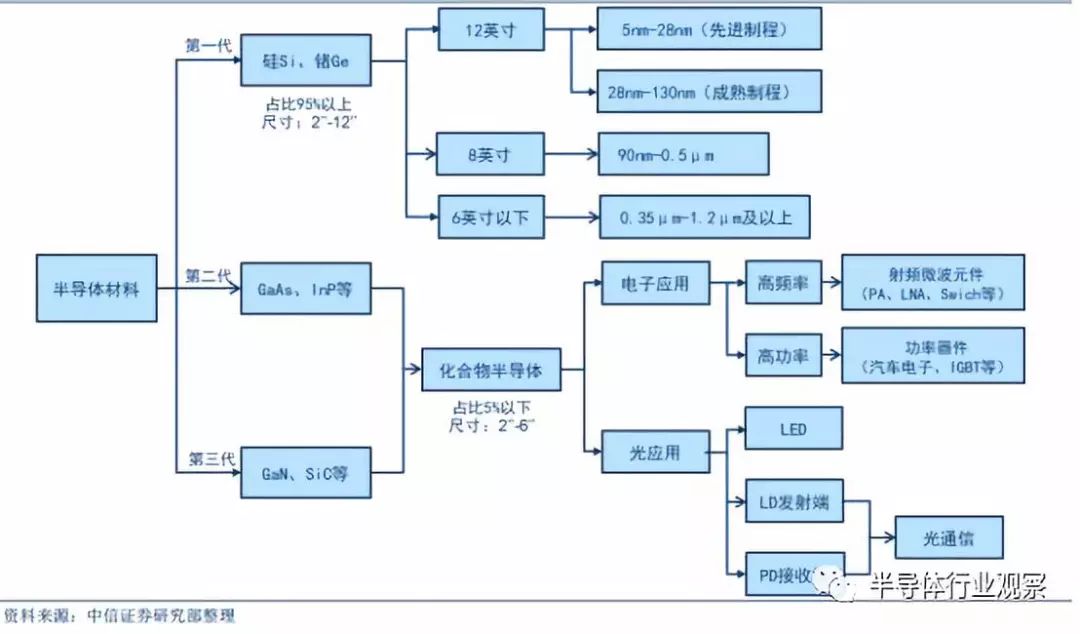
Basic Framework of Semiconductor Wafer Materials
In the 1950s, germanium (Ge) was the first semiconductor material used, initially in discrete devices. The advent of integrated circuits was an important step forward for the semiconductor industry. In July 1958, Jack Kilby at Texas Instruments in Dallas manufactured the first integrated circuit using a piece of germanium semiconductor material as the substrate.

Semiconductor Industry Chain Process
However, germanium devices have shortcomings in high-temperature resistance and radiation resistance, and were gradually replaced by silicon (Si) devices in the late 1960s. Silicon is extremely abundant, with mature purification and crystallization processes, and the silicon dioxide (SiO2) thin films formed by oxidation have excellent insulation properties, significantly improving the stability and reliability of devices. Therefore, silicon has become the most widely used semiconductor material. In terms of semiconductor device output, over 95% of semiconductor devices and more than 99% of integrated circuits globally use silicon as the substrate material.
In 2017, the global semiconductor market size was approximately $412.2 billion, while the compound semiconductor market size was about $20 billion, accounting for less than 5%. In terms of wafer substrate market size, the annual sales of silicon substrates in 2017 were $8.7 billion, GaAs substrates were about $800 million, GaN substrates were about $100 million, and SiC substrates were about $300 million. Silicon substrate sales accounted for over 85%. In the 21st century, its dominant and core position will remain unchanged. However, the physical properties of Si materials limit their application in optoelectronics and high-frequency, high-power devices.
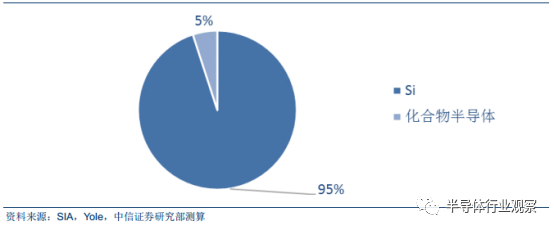
Semiconductor Market Share (by Material)
Since the 1990s, second-generation semiconductor materials represented by gallium arsenide (GaAs) and indium phosphide (InP) have begun to emerge. Materials like GaAs and InP are suitable for making high-speed, high-frequency, high-power, and optoelectronic devices, making them excellent materials for high-performance microwave, millimeter-wave devices, and optoelectronic devices, widely used in satellite communications, mobile communications, optical communications, GPS navigation, and more. However, GaAs and InP materials are scarce, expensive, and toxic, which can pollute the environment. InP is even considered a suspected carcinogen, which greatly limits the application of second-generation semiconductor materials.
The third-generation semiconductor materials mainly include SiC and GaN, which are also known as wide-bandgap semiconductor materials because their bandgap (Eg) is greater than or equal to 2.3 electron volts (eV). Compared to first and second-generation semiconductor materials, third-generation semiconductor materials have advantages such as high thermal conductivity, high breakdown field strength, high saturation electron drift velocity, and high bond energy, meeting the new requirements of modern electronic technology for high temperature, high power, high voltage, high frequency, and radiation resistance. They are the most promising materials in the semiconductor field, with important application prospects in defense, aerospace, oil exploration, optical storage, and many strategic industries that can reduce energy losses by more than 50%, and can reduce equipment size by more than 75%, marking a milestone in the development of human technology.

Comparison of Wafer Material Properties
Compound semiconductors refer to semiconductor materials formed from two or more elements, with most second and third-generation semiconductors belonging to this category. According to the number of elements, they can be divided into binary compounds, ternary compounds, quaternary compounds, etc. Binary compound semiconductors can be further divided into III-V, IV-IV, II-VI groups based on the positions of the constituent elements in the periodic table. Compound semiconductor materials represented by gallium arsenide (GaAs), gallium nitride (GaN), and silicon carbide (SiC) have become the fastest developing, most widely used, and largest produced semiconductor materials after silicon. Compound semiconductor materials have superior performance and energy band structures:
(1) High electron mobility;
(2) High frequency characteristics;
(3) Wide bandwidth;
(4) High linearity;
(5) High power;
(6) Material selection diversity;
(7) Radiation resistance.
Therefore, compound semiconductors are mainly used in the manufacture of RF devices, optoelectronic devices, power devices, etc., with great development potential; silicon devices are mainly used in logic devices and memory, and they are irreplaceable to each other.
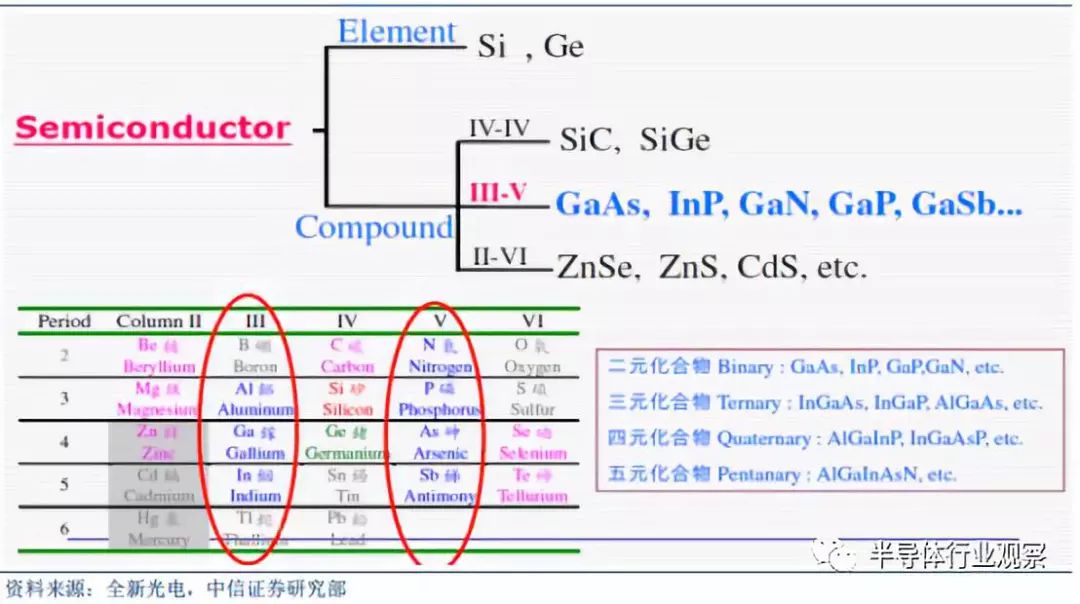
Compound Semiconductor Materials
Wafer Preparation: Substrate and Epitaxy Processes
Wafer preparation includes two major steps: substrate preparation and epitaxy processes. The substrate is a wafer piece made from single crystal semiconductor materials, which can either directly enter the wafer manufacturing stage to produce semiconductor devices or undergo epitaxy processing to produce epitaxial wafers. Epitaxy refers to the process of growing a new single crystal layer on a single crystal substrate, which can be the same material as the substrate or a different material. Epitaxy can produce a wider variety of materials, providing more choices for device design.
The basic steps of substrate preparation are as follows: Semiconductor polycrystalline materials are first purified, doped, and pulled to obtain single crystal materials. For silicon, silicon sand is first refined and reduced to metallurgical-grade coarse silicon with a purity of about 98%, and then purified multiple times to obtain electronic-grade high-purity polycrystalline silicon (purity reaching 99.9999999% or more, 9 to 11 nines), which is then pulled in a furnace to obtain single crystal silicon rods. The single crystal material is processed mechanically, chemically treated, polished, and quality tested to obtain polished single crystal wafers that meet certain standards (thickness, crystal orientation, flatness, parallelism, and damage layer). The purpose of polishing is to further remove the residual damage layer from the processed surface, and the polished wafers can be directly used to make devices or serve as substrate materials for epitaxy.
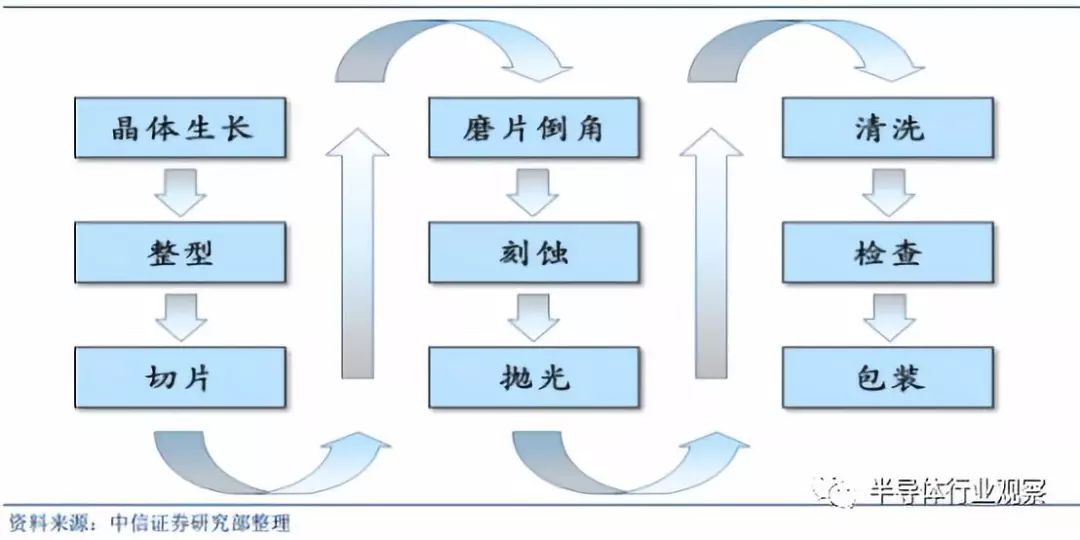
Basic Steps of Substrate Preparation
The epitaxy growth processes currently mainly include MOCVD (Metal-Organic Chemical Vapor Deposition) technology and MBE (Molecular Beam Epitaxy) technology. For example, New Optoelectronics uses MOCVD, while EPISTAR uses MBE technology.
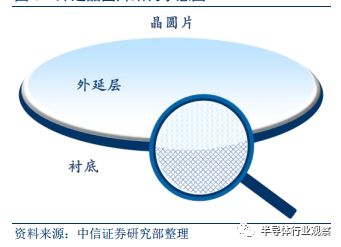
Structure Diagram of Epitaxial Wafer
In comparison, MOCVD technology has a faster growth rate and is more suitable for large-scale industrial production, while MBE technology is more suitable for certain cases such as PHEMT structures and the production of Sb compound semiconductors. HVPE (Hydride Vapor Phase Epitaxy) technology is mainly applied in GaN substrate production. LPE (Liquid Phase Epitaxy) technology is mainly used for silicon wafers, which have now been largely replaced by vapor deposition technology.
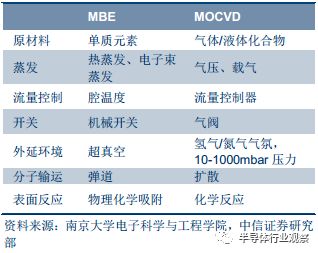
Comparison of MBE and MOCVD Technologies
Wafer Size: Uneven Technological Development
Silicon wafers can reach a maximum size of 12 inches, while the maximum size for compound semiconductor wafers is 6 inches. The mainstream size for silicon wafer substrates is 12 inches, accounting for about 65% of global silicon wafer production capacity, while 8 inches is also a commonly used mature process wafer, accounting for 25% of global capacity. The mainstream sizes for GaAs substrates are 4 inches and 6 inches; the mainstream supply sizes for SiC substrates are 2 inches and 4 inches; and for GaN self-supporting substrates, 2 inches is the main size.

Corresponding Sizes of Substrate Wafers
Currently, SiC substrates have reached a size of 6 inches, with 8 inches under development (II-VI has produced samples). However, the mainstream size still remains 4 inches. The main reasons are: (1) Currently, the cost of 6-inch SiC wafers is about 2.25 times that of 4-inch wafers, and is expected to be about 2 times by 2020, with no significant improvement in cost reduction, and changing equipment requires additional capital expenditure, so the advantage of 6 inches is only in production efficiency; (2) The quality of 6-inch SiC wafers is lower compared to 4-inch wafers, hence currently, 6-inch wafers are mainly used for manufacturing diodes, as manufacturing diodes on lower quality wafers is simpler than on MOSFETs.

Corresponding Wafer Sizes for Epitaxy Growth
GaN materials lack single crystal materials in nature, hence epitaxy has long been performed on heterogeneous substrates such as sapphire, SiC, and Si. Nowadays, through Hydride Vapor Phase Epitaxy (HVPE) and ammonothermal methods, 2-inch, 3-inch, and 4-inch GaN self-supporting substrates can be produced. Currently, in commercial applications, epitaxy on heterogeneous substrates is still predominant, with GaN self-supporting substrates having the most applications in lasers, achieving higher luminous efficiency and quality.
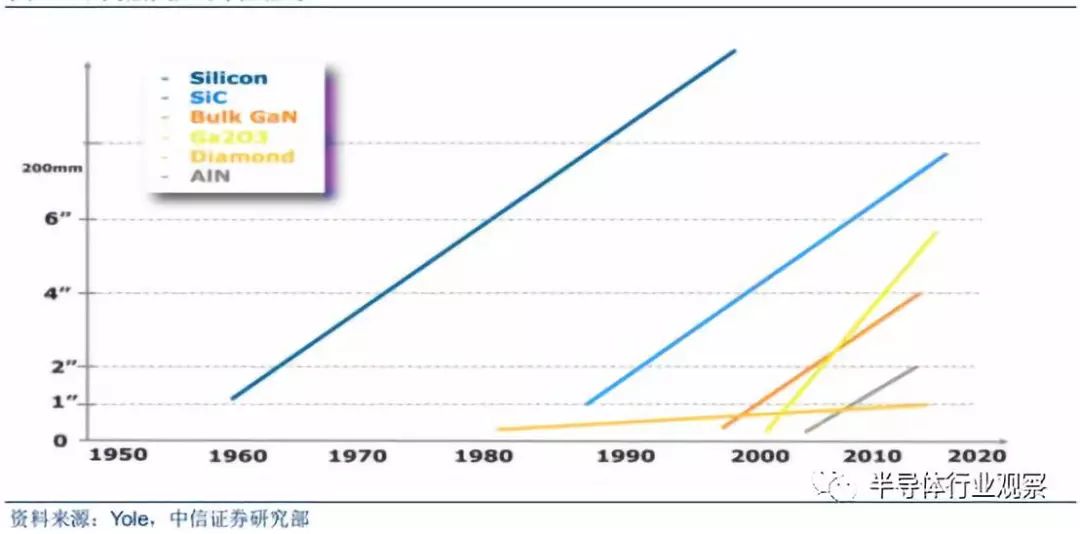
Development History of Different Wafer Sizes
Silicon: Mainstream Market, Strong Demand in Niche Areas
In terms of the supply landscape for silicon wafers, Japanese manufacturers dominate, maintaining a stable oligopoly. Japanese manufacturers account for over 50% of the silicon wafer market. The top five manufacturers hold over 90% of the global market share. Among them, Shin-Etsu Chemical from Japan accounts for 27%, SUMCO from Japan accounts for 26%, together accounting for 53%, which is more than half. Taiwan’s GlobalWafers acquired the American SunEdison Semiconductor during the low point of the wafer industry in December 2016, rising from sixth to third place, with a share of 17%. Germany’s Siltronic accounts for 13%, and Korea’s SK Siltron (formerly LG Siltron, acquired by SK Group in 2017) accounts for 9%. Unlike the top four manufacturers, SK Siltron only supplies Korean customers.
Additionally, there are companies like France’s Soitec, Taiwan’s Taisil, Hejing, and Jiajing, with relatively small shares. The major manufacturers have different categories and sizes of wafers they supply, but overall, the top three manufacturers offer a diverse range of products. The top three manufacturers can supply Si annealed wafers, SOI wafers, among which only Shin-Etsu from Japan can supply 12-inch SOI wafers. Germany’s Siltronic and Korea’s SK Siltron do not provide SOI wafers, and SK Siltron does not supply Si annealed wafers. The sizes of Si polished wafers and Si epitaxial wafers are basically the same among all manufacturers.

Competitiveness of Silicon Wafer Suppliers
For the past 15 years, Japanese manufacturers have consistently maintained over 50% of the silicon wafer market share. There has been no significant regional transfer of silicon wafer production capacity. According to Gartner, in 2007, the first place in silicon wafer market share was Shin-Etsu from Japan (32.5%), the second was SUMCO from Japan (21.7%), and the third was Siltronic from Germany (14.8%); in 2002, the first place was also Shin-Etsu (28.9%), the second was SUMCO (23.3%), and the third was Siltronic (15.4%). A recent significant market change occurred when Taiwan’s GlobalWafers acquired the American SunEdison, rising from sixth to third place. However, Japanese manufacturers still hold over 50% of the market share.
Japan’s competitiveness in the fab segment has declined while maintaining a leading position in materials. In the mid-1980s, Japan’s semiconductor industry held over 50% of the global market share. Japan’s advantages in semiconductor materials have continued since last century, while its competitiveness in wafer manufacturing has significantly weakened, with a notable regional shift occurring in the semiconductor fab segment. The reasons include that the fab segment is closer to the demand side and experiences greater market fluctuations; however, silicon wafers have a high degree of homogeneity, and new entrants need a considerable amount of time to validate their products with customers; moreover, wafers account for less than 10% of the cost in wafer foundries, and foundries are reluctant to risk switching to immature products for a small price difference.

Changes in Silicon Wafer Suppliers’ Shares Over the Past 15 Years
Silicon Wafer Demand Supplier Landscape: Dominated by Overseas, Domestic Suppliers Show Highlights
In IC design, major players control the competitive barriers, and since 2018, AI chips have become a new growth driver. Qualcomm, Broadcom, MediaTek, Apple, and other manufacturers are the strongest, while China’s HiSilicon has risen. With technological development leading to upgrades in terminal products, the demand for IC products in innovative applications such as AI chips continues to expand, with the AI chip market expected to grow from about $600 million in 2016 to $2.6 billion by 2020, with a CAGR of 43.9%. Currently, domestic and foreign IC design manufacturers are actively laying out the AI chip industry. NVIDIA is the market leader in AI chips, while AMD and Tesla are jointly developing AI chips for autonomous driving.
For domestic manufacturers, Huawei’s HiSilicon was the first to launch the Kirin 970 AI chip in September 2017, which has been successfully integrated into models like the P20; Bitmain’s BM1680, the world’s first tensor acceleration computing chip, has been successfully used in Bitcoin mining machines; and Cambricon’s 1A processor, Horizon’s Journey, and Sunrise processors have also emerged. IC design must be demand-oriented to better serve downstream customers. HiSilicon, Spreadtrum, and other mobile processing chip and baseband chip manufacturers have rapidly risen to the top ten global IC design firms, thanks to the explosive growth of China’s smartphone market in recent years. HiSilicon chips have been fully applied in Huawei smartphones, while manufacturers like Samsung and Xiaomi have also adopted self-developed chips. Today, China is the largest terminal demand market globally, giving domestic IC design firms a significant development advantage.
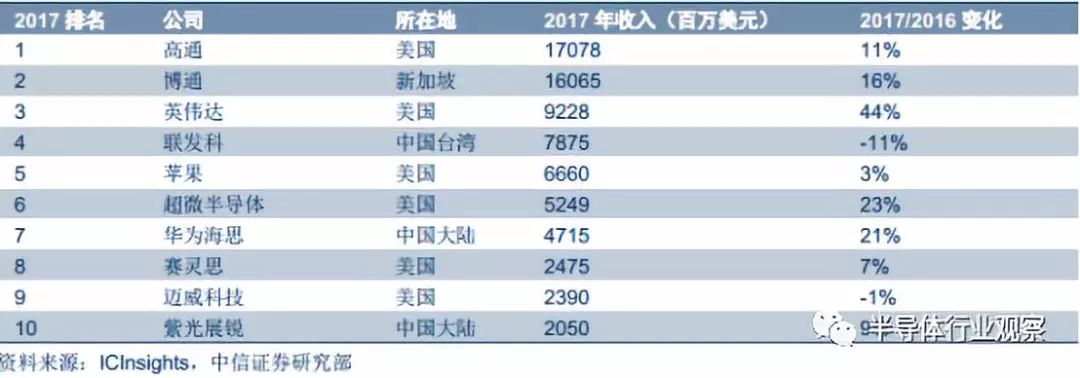
Global IC Design Manufacturers Ranking in 2017
In terms of foundry manufacturing, Capex is rapidly increasing, led by giants like Samsung and TSMC. In terms of capital expenditure, the competition in the global advanced process chip market is fierce, with the top three chip manufacturers, Samsung, Intel, and TSMC, each having Capex in the tens of billions of dollars, reaching $44 billion, $12 billion, and $10.8 billion in 2017, respectively. It is expected that Samsung’s total Capex will approach $110 billion over the next three years, while Intel and TSMC’s Capex for 2018 is expected to reach $14 billion and $12 billion, respectively, both showing significant growth, benefiting giants to occupy the market through advanced process technology research and expansion of production lines.
In terms of process technology, TSMC is at the forefront of the industry, currently mass-producing 10nm process chips, with 7nm process set to enter mass production in 2018; the most advanced foundry in mainland China, SMIC, currently has the capability for 28nm process mass production, while TSMC had already achieved 28nm mass production capability as early as 2011, showing a significant gap compared to mainland manufacturers.

Global Pure-Play Foundry Manufacturers Ranking in 2016
In terms of packaging and testing, the trend of high-end manufacturing + packaging and testing integration is becoming apparent, with domestic manufacturers narrowing the technology gap with Taiwanese manufacturers. Packaging and testing technology has developed through four generations, and at the highest-end technology level, manufacturing and packaging have achieved integration, with TSMC establishing two major high-end packaging ecosystems, CoWoS and InFO, and planning to double the InFO production capacity to meet the demand for Apple’s A12 chip.
Leading packaging manufacturer ASE has mastered cutting-edge packaging and microelectronics manufacturing technologies, being the first to mass-produce TSV/2.5D/3D related products, and in March 2018, ASE formed a joint venture with TDK to expand its SiP layout. Due to the relatively low technical threshold of packaging technology, domestic manufacturers are rapidly catching up, and the technology gap with leading global manufacturers is gradually narrowing. Domestic manufacturers have basically mastered advanced technologies such as SiP, WLCSP, and FOWLP, with applications in FC, SiP, and other packaging technologies already achieving mass production.

Global Semiconductor Packaging Manufacturers Ranking in 2017
A new round of regional transfer is oriented towards mainland China. Although the top IC design, manufacturing, and packaging companies are mainly located in the United States and Taiwan, overall, the semiconductor manufacturing industry has undergone a historical development process from the United States to Japan and then to Korea and Taiwan: In the 1950s, the semiconductor industry originated in the United States, with the transistor invented in 1947 and the integrated circuit in 1958. In the 1970s, semiconductor manufacturing shifted from the United States to Japan, with DRAM being an important entry point for the industry development in Japan and Korea. By the 1980s, Japan had already taken the lead in the semiconductor industry. In the 1990s, driven by DRAM, the industry shifted to Korean firms like Samsung and Hynix, while the wafer foundry segment shifted to Taiwan, with firms like TSMC and UMC rising. In the 2010s, the explosion of smartphones and mobile internet, as well as the rapid growth of IoT, big data, cloud computing, and artificial intelligence industries, led to a demographic dividend and demand transfer that may drive manufacturing transfer, indicating that mainland China has become the destination for a new round of regional transfer.

Historical Transfer of the Global Semiconductor Industry in the US-Japan-Korea Regions
Silicon Wafer Downstream Application Split: Size and Process Drive Technological Progress
Wafer size and process technology develop in parallel, with each process stage corresponding to wafer sizes. (1) Process advancement → transistor miniaturization → transistor density increases exponentially → performance improvement. (2) Increasing wafer size → more chips produced per wafer → efficiency improvement → cost reduction. Currently, the production equipment for 6-inch and 8-inch silicon wafers has generally been fully depreciated, resulting in lower production costs, primarily producing mature processes above 90nm. Some processes have outputs on wafers of adjacent sizes. For 5nm to 0.13μm, 12-inch wafers are used, where 28nm serves as the boundary distinguishing advanced processes from mature processes, mainly because new designs and processes such as FinFET are introduced after 28nm, significantly increasing the difficulty of wafer manufacturing.
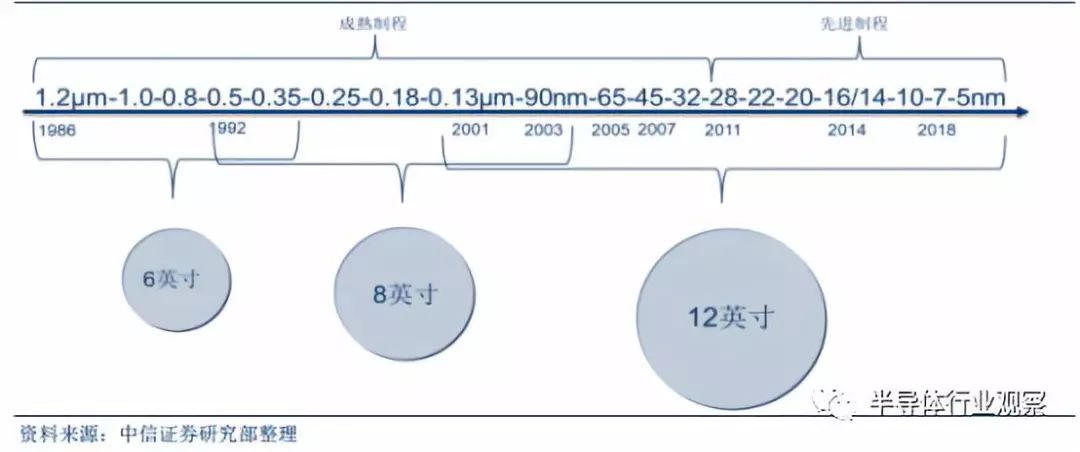
Correspondence Between Silicon Wafer Sizes and Processes
In terms of total wafer demand, the 12-inch NAND and 8-inch markets are core driving forces. The proportion of 12-inch silicon wafers for storage reaches 35%, making it the largest, followed by 8-inch and 12-inch logic. In terms of product sales, among global integrated circuit products, memory accounts for about 27.8%, logic circuits account for 33%, microprocessor chips and analog circuits account for 21.9% and 17.3%, respectively. According to our forecasts, global demand for 12-inch silicon wafers in the second half of 2016 was approximately 5.1 million pieces/month, with demand for logic chips at 1.3 million pieces/month, DRAM demand at 1.2 million pieces/month, NAND demand at 1.6 million pieces/month, and other demands including NORFlash, CIS, etc., at 1 million pieces/month; 8-inch silicon wafer demand was 4.8 million pieces/month, which, when converted to 12-inch wafers, is about 2.13 million pieces/month, while demand for wafers below 6 inches is equivalent to 620,000 12-inch wafers/month.

Demand Structure for 12-inch, 8-inch, and 6-inch Wafers
Estimating this, the demand for 12-inch wafers for storage, including NAND and DRAM, accounts for about 35% of total demand, while 8-inch wafer demand accounts for about 27%, and demand for 12-inch wafers for logic chips accounts for about 17%. In terms of demand, memory currently contributes the most to wafer demand, followed by 8-inch for low-end applications.
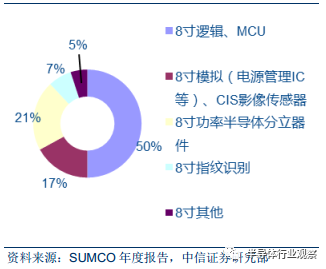
Demand Structure for 8-inch Wafers

Correspondence Between Wafer Sizes and Product Types
Looking at downstream specific applications, 12-inch wafers below 20nm advanced processes perform strongly, primarily used in mobile devices and high-performance computing fields, including smartphone main chips, computer CPUs, GPUs, high-performance FPGAs, ASICs, etc. The 14nm-32nm advanced processes are applied in DRAM, NAND Flash memory chips, mid-to-low-end processor chips, image processors, digital TV set-top boxes, and other applications.
12-inch wafers with 45-90nm mature processes are mainly used in fields with slightly lower performance requirements and high cost and production efficiency demands, such as mobile basebands, WiFi, GPS, Bluetooth, NFC, ZigBee, NOR Flash chips, MCUs, etc. 12-inch or 8-inch wafers from 90nm to 0.15μm are mainly used for MCUs, fingerprint recognition chips, image sensor chips, power management chips, LCD driver ICs, etc. 8-inch wafers from 0.18μm to 0.25μm are mainly used for non-volatile storage such as bank cards, SIM cards, etc., while those above 0.35μm are mainly for power devices like MOSFETs and IGBTs.
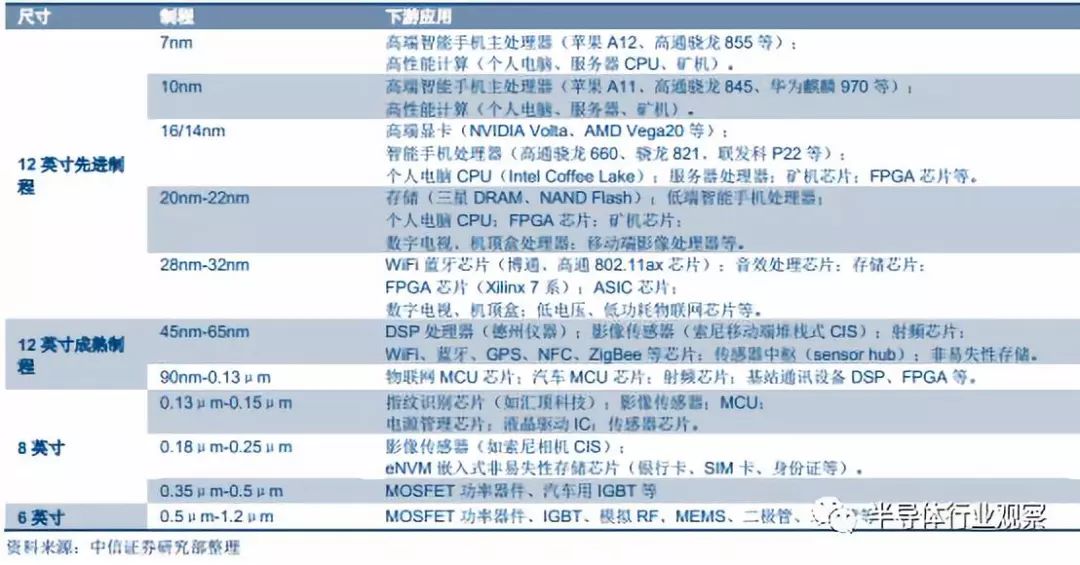
Demand Split for Applications Corresponding to Process and Size
Compound Semiconductors: Key Materials for 5G, 3D Sensing, and Electric Vehicles
The supply landscape for compound semiconductor wafers is dominated by Japan, the US, and Germany, forming an oligopoly. In the substrate market, high technical barriers lead to a market dominated by Japanese, American, and German manufacturers. Currently, GaAs substrates are mainly held by four companies: Japan’s Sumitomo Electric, Germany’s Freiberg, America’s AXT, and Japan’s Sumitomo Chemical, with their combined share exceeding 90%. Sumitomo Chemical acquired Hitachi Cable’s (Hitachi Metals) compound semiconductor business in 2011 and transferred it to its subsidiary Sciocs in 2016. Currently, GaN self-supporting substrates are mainly monopolized by three Japanese companies: Sumitomo Electric, Mitsubishi Chemical, and Sumitomo Chemical, with a combined share exceeding 85%. The leading SiC substrate manufacturer is America’s Cree (Wolfspeed division), holding over one-third of the market, followed by Germany’s SiCrystal, America’s II-VI, and Dow Corning, with a combined share exceeding 90%. In recent years, China has also seen the emergence of SiC substrate manufacturers with certain production capabilities, such as Beijing TianKe HeDa Semiconductor Co., Ltd.

Competitiveness of Compound Semiconductor Suppliers
In the epitaxy growth market, UK-based IQE holds over 60% market share, being the absolute leader. UK-based IQE and Taiwan’s New Optoelectronics together account for 80% of the market. Epitaxy growth mainly includes MOCVD (Metal-Organic Chemical Vapor Deposition) technology and MBE (Molecular Beam Epitaxy) technology. For example, both IQE and New Optoelectronics use MOCVD, while EPISTAR employs MBE technology. HVPE (Hydride Vapor Phase Epitaxy) technology is primarily applied in GaN substrate production.

Competitiveness of Compound Semiconductor Epitaxy Suppliers
Demand Supplier Landscape for Compound Semiconductor Wafers: Coexistence of IDM and Foundry Giants
The compound semiconductor industry chain presents an oligopolistic competitive landscape. IDM-type manufacturers include Skyworks, Broadcom (Avago), Qorvo, Anadigics, etc. In 2016, the global compound semiconductor IDM market exhibited a three-player oligopoly, with Skyworks, Qorvo, and Broadcom occupying 30.7%, 28%, and 7.4% of the market share in the GaAs field, respectively. The industry chain is showing a multi-mode integration trend, with design companies de-integrating and IDM capacity outsourcing becoming an inevitable trend.

Global Gallium Arsenide Device (Including IDM) Value Distribution
The compound semiconductor wafer foundry market is dominated by WIN Semiconductors, holding a 66% market share, making it the absolute leader. The second and third places are held by AWSC and GCS, accounting for 12% and 9%, respectively. Domestic designs are pushing for foundries, and a mainland compound semiconductor foundry leader is emerging. Currently, domestic PA designs have seen the emergence of companies like RDA, vanchip, Han Tianxia, and Feixiang Technology.
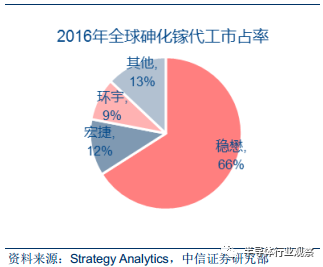
Global GaAs Foundry Market Share
Domestic compound semiconductor design companies have currently occupied low-end applications in consumer electronics markets such as 2G/3G/4G/WiFi. Sanan Optoelectronics is mainly focused on LED applications and is expected to fill the domestic gap in compound semiconductor foundries, with its fundraising production line construction progressing smoothly, expected to achieve a capacity of 4000-6000 pieces/month by the end of 2018, becoming the first large-scale GaAs/GaN compound wafer foundry enterprise in mainland China.
Downstream Applications of Compound Semiconductor Wafers: Unique Performance, Independent System
Downstream specific applications of compound semiconductors can be divided into two main categories: optical devices and electronic devices. Optical devices include LED light-emitting diodes, LD laser diodes, PD photodetectors, etc. Electronic devices include PA power amplifiers, LNA low-noise amplifiers, RF switches, digital-to-analog converters, microwave monolithic ICs, power semiconductor devices, Hall elements, etc. For GaAs materials, SC GaAs (single crystal gallium arsenide) is mainly applied in optical devices, while SI GaAs (semi-insulating gallium arsenide) is mainly applied in electronic devices.
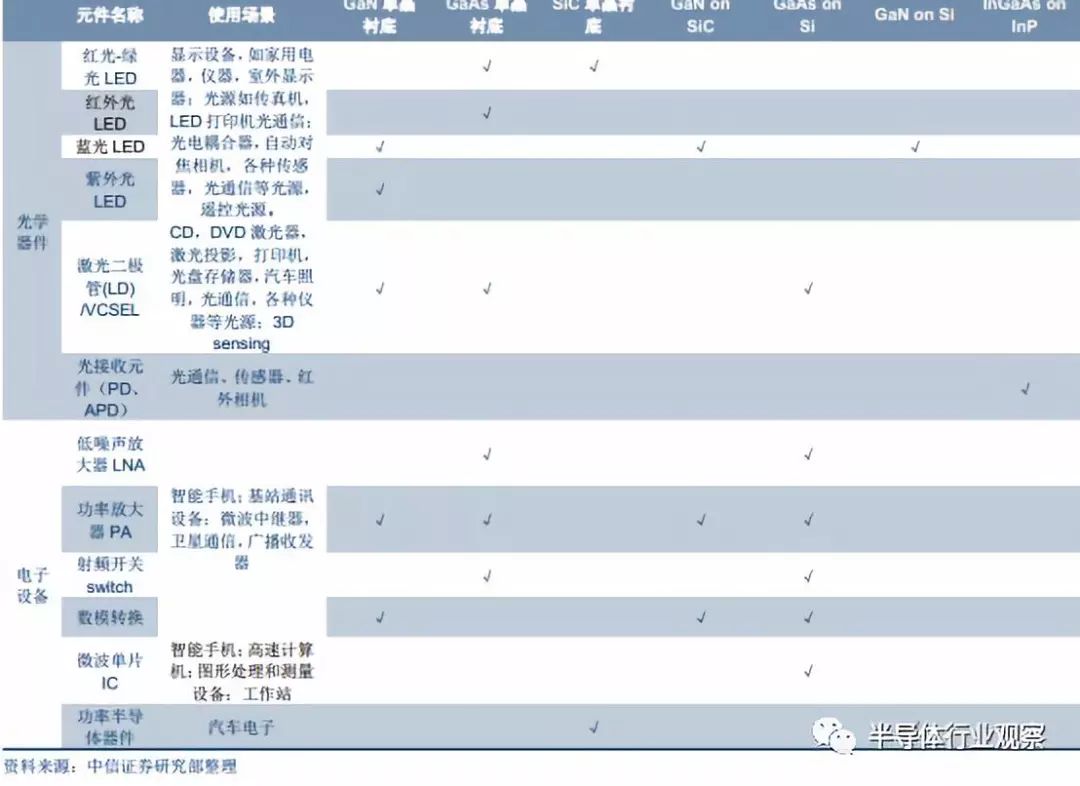
Correspondence Between Compound Semiconductor Wafers and Downstream Applications
In optical devices, LEDs account for the largest share, while LD/PD and VCSEL have significant growth potential. Cree derives about 70% of its revenue from LEDs, with the rest from power, RF, and SiC wafers. SiC substrates account for 80% of the market from diodes, making SiC the most mature among all wide-bandgap semiconductor substrates. Different LED materials produce different wavelengths of light: GaAs LEDs emit red and green light, GaP emits green light, SiC emits yellow light, and GaN emits blue light. Utilizing GaN blue LEDs to excite yellow phosphor materials can produce white LEDs. Additionally, GaAs can produce infrared LEDs, commonly used in remote controls, while GaN can produce ultraviolet LEDs. GaAs and GaN can produce red and blue laser emitters, respectively, used in reading CDs, DVDs, and Blu-ray discs.

Output Power and Frequency Corresponding to Various Materials and Processes
In electronic devices, the main applications are RF and power applications. GaN on SiC, GaN self-supporting substrates, GaAs substrates, and GaAs on Si are primarily used for RF semiconductors (such as RF front-end PAs); while GaN on Si and SiC substrates are mainly used for power semiconductors (such as automotive electronics).
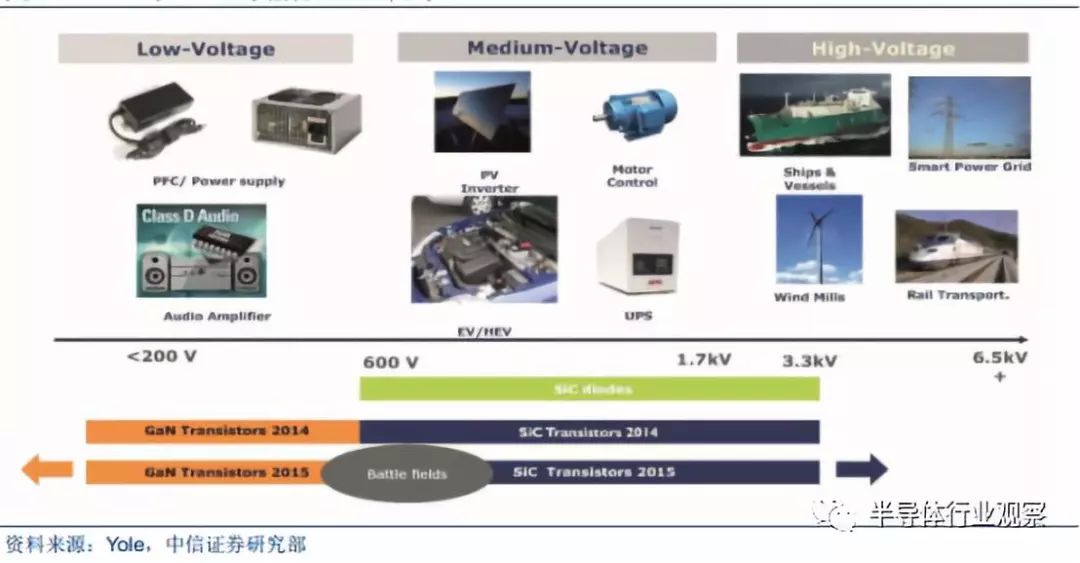
Comparison of GaN and SiC Power Device Applications
Due to its high power density, GaN has unique advantages in high-power devices in base stations. Compared to silicon substrates, SiC substrates have better thermal conductivity characteristics. Currently, over 95% of GaN RF devices use SiC substrates, such as those based on SiC processes used by Qorvo, while silicon-based GaN devices can be manufactured on 8-inch wafers, providing greater cost advantages. In the power semiconductor field, SiC substrates and GaN on Silicon only compete in a small number of areas. The boundary between them is around 600V.
Analysis of Major Downstream Applications: Examining Chip Domesticization from Process Materials
(1) Smartphones: IC design is catching up first, while foundry and materials still need breakthroughs.
The core chips in smartphones involve advanced processes and compound semiconductor materials, with low domesticization rates. For instance, the domestic chips used in Huawei smartphones can roughly indicate the “upper limit” of domestic chips.
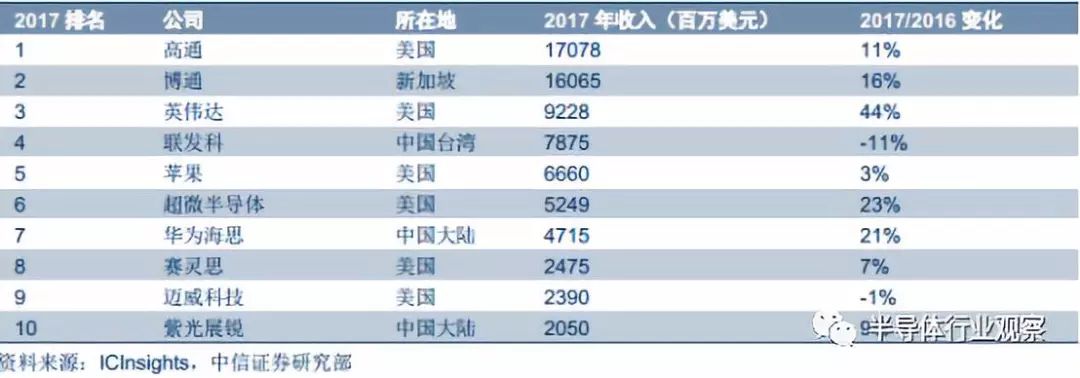
Internal Chip Correspondence of Huawei P20
Currently, Huawei’s HiSilicon can independently design CPUs, along with fabless design companies like Xiaomi’s Pinecone, but due to the use of the most advanced 12-inch processes, manufacturing relies mainly on Taiwanese companies. There are currently no domestic companies producing DRAM or NAND flash at scale; the front-end LTE modules and WiFi/Bluetooth modules use GaAs materials, with production concentrated in American IDM companies like Skyworks and Qorvo, as well as Taiwanese foundries like WIN Semiconductors, with no GaAs foundries in mainland China. RF transceiver modules, PMICs, and audio ICs can be designed by HiSilicon and then outsourced for foundry production, while charging control ICs, NFC control ICs, and sensors such as pressure and gyroscopes are mainly supplied by American and European IDM companies. Overall, the domesticization rate of core chips in smartphones remains low, with some chips like DRAM, NAND, and RF modules having almost zero domesticization.
Taking the mainstream flagship smartphone iPhone X as an example, we can roughly see the position of mainland Chinese chip manufacturers in the global supply chain. The CPU uses Apple’s self-designed chip + TSMC’s advanced process foundry, while DRAM and NAND come from Korean/Japanese/American IDM manufacturers; the baseband comes from Qualcomm’s design + TSMC’s advanced process foundry; the RF modules use GaAs materials from IDM manufacturers like Skyworks and Qorvo or from Broadcom + WIN Semiconductors; analog chips, audio ICs, NFC chips, touch ICs, image sensors, etc., are all sourced from companies outside mainland China, indicating that mainland Chinese chips account for zero in Apple’s supply chain. However, most components, except chips and screens, have suppliers from mainland China, with some even monopolized by mainland manufacturers. Thus, it is evident that the competitiveness of Chinese chip companies remains low on a global scale.

Internal Chip Correspondence of iPhone X
(2) Communication Base Stations: Extremely High Dependence on American Chips for High-Power RF Chips
The dependence on foreign chips in communication base stations is extremely high, primarily from American chip companies. Currently, base station systems mainly consist of baseband processing units (BBU) and remote radio units (RRU), with typically one BBU corresponding to multiple RRU devices. In comparison, RRU chips have a lower domesticization rate and a higher dependence on foreign sources.

BBU + RRU System Diagram
The main challenge lies in RRU chip devices involving high-power RF scenarios, typically using GaAs or GaN materials, while mainland China lacks the corresponding industrial chain.
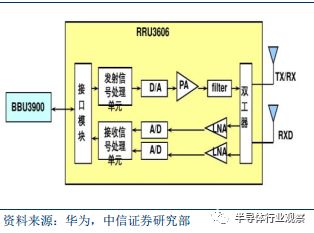
RRU Internal Chips Have the Highest Threshold
American companies monopolize high-power RF devices. Specifically, the PA, LNA, DSA, and VGA chips in current RRU devices mainly use GaAs or GaN processes, sourced from companies like Qorvo and Skyworks, with GaN devices typically being based on SiC substrates, i.e., GaN on SiC. RF transceivers and digital-to-analog converters use silicon-based and GaAs processes, mainly from companies like TI, ADI, IDT, all of which are American companies, indicating that communication base station chips have an extremely high dependence on American manufacturers.

Main Chips in Base Station Communication Equipment
(3) Automotive Electronics: Industry Technology Maturing, Some Achievements in Domesticization
Automotive electronics primarily require semiconductor devices such as MCUs, NOR Flash, and IGBTs. Traditional automotive systems have a high demand for MCUs, including power control, safety control, engine control, chassis control, and onboard electrical appliances. New energy vehicles also include electronic control units (ECU), power control units (PCU), vehicle control units (VCU), hybrid vehicle controllers (HCU), battery management systems (BMS), and core components of inverters (IGBT components).

Internal Chips in Traditional Vehicles
Additionally, the above-related systems and emergency brake systems, tire pressure monitoring systems, airbag systems, etc., require NOR Flash for code storage. MCUs typically use 8-inch or 12-inch 45nm~0.15μm mature processes, while NOR Flash typically uses 45nm~0.13μm mature processes, with domestic production having basically been achieved.
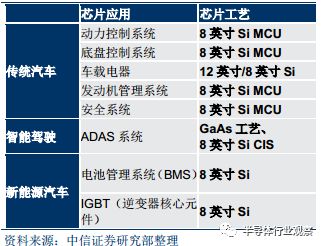
Chips Inside Automotive Systems
Semiconductor devices used in intelligent driving include high-performance computing chips and ADAS systems. High-performance computing chips currently use 12-inch advanced processes, while the millimeter-wave radar in ADAS systems involves GaAs materials, which cannot be mass-produced domestically at this time.
(4) AI and Mining Machine Chips: New Growth Drivers, Domestic Design Firms Achieving Breakthroughs
AI chips and mining machine chips belong to high-performance computing, requiring advanced processes. In AI and blockchain scenarios, traditional CPU computing power is insufficient, making new architecture chips a development trend. Currently, there are traditional architecture paths like GPUs, FPGAs, and ASICs (TPUs, NPUs, etc.), as well as paths that completely overturn traditional computing architectures by adopting structures that simulate human brain neurons to enhance computing power. In the cloud domain, the GPU ecosystem is leading, while specialization in terminal scenarios is the future trend.
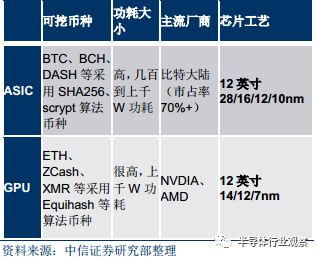
Overview of Main Mining Machine Chips
Outlook: Some Areas Expected to Break Through First, More Participation in Global Division of Labor
Currently, the level of domesticization is low, and the semiconductor industry relies on global cooperation. Despite the rapid development of China’s semiconductor industry, the overall situation includes low overall capacity, weak global market competitiveness, low domesticization in core chip areas, and high dependence on foreign sources. China’s semiconductor industry chain is highly dependent on foreign countries in several high-end fields such as materials, equipment, manufacturing, and design, and achieving self-replacement in the semiconductor industry will require a long journey.
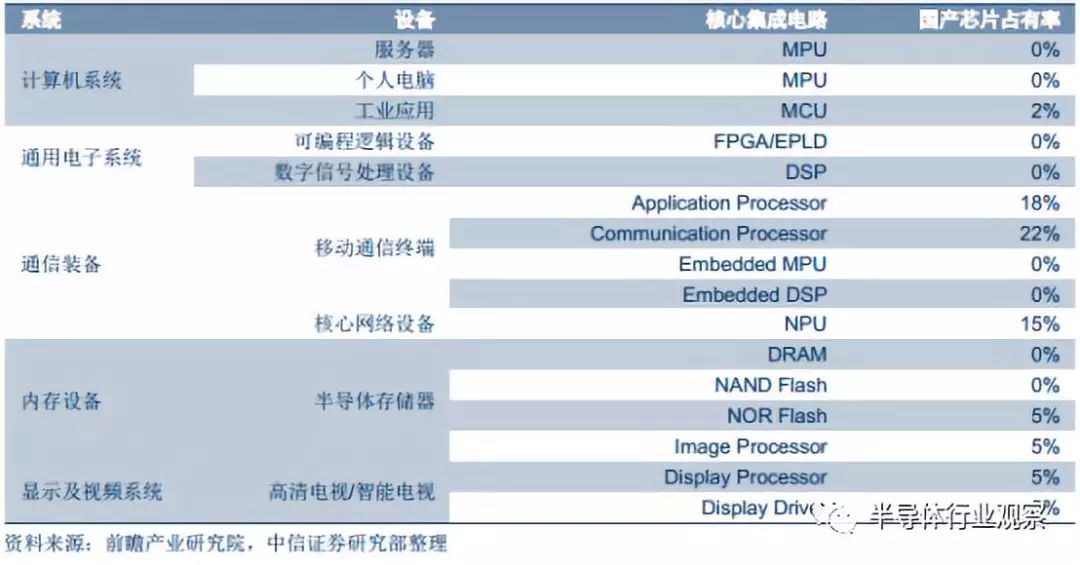
Current Share of Domestic Core Integrated Circuit Chips
According to IC Insight data, in 2015, China’s integrated circuit companies held only 3% of the global market share, while the US, South Korea, and Japan accounted for 54%/20%/8%, respectively. In fact, even the US, South Korea, and Japan cannot achieve 100% self-sufficiency in the semiconductor industry chain. For example, in advanced process manufacturing, core equipment such as photolithography machines still relies on the Netherlands’ ASML. More participation in global division of labor, gradually increasing domesticization share in the process, is a practical path for the development of the semiconductor industry.
China’s mainland chip downstream demand terminal market is fully prepared, and the supply side is expected to shift towards mainland China. (1) Demand side: The downstream terminal application market is fully prepared, and the scale conditions are gradually maturing. As global terminal product capacity shifts to China, China has become the global manufacturing base for terminal products, with China’s automobile and smartphone shipments accounting for 29.8% and 33.6% of the global total, respectively, in 2017. Chip demand fully encompasses both silicon-based and compound semiconductor markets, and the chip market space is enormous. (2) Supply side: Currently, there are only a few IC design, wafer foundry, and storage manufacturers in mainland China with significant output value, and the technology level has not yet reached a leading level. Mid-to-high-end chip manufacturing and compound semiconductor chips are heavily reliant on imports. As downstream demand gradually shifts to mainland China with industries like smartphones, demand transfer may drive manufacturing transfer, and the downstream chip supply side is beginning to shift to mainland China.

Domestic policies accelerate the development of the semiconductor industry. In recent years, China’s integrated circuit support policies have been intensively issued, with financing, taxation, and subsidy policies continuously optimized. In particular, the “National Integrated Circuit Industry Development Promotion Outline” issued in June 2014 has set the tone for “design as the leader, manufacturing as the foundation, equipment and materials as support,” aiming to promote the development of China’s integrated circuit industry with 2015, 2020, and 2030 as growth cycles: the goal is to exceed 350 billion yuan in sales revenue for the integrated circuit industry by 2015; to exceed 20% annual growth rate in sales revenue for the integrated circuit industry by 2020; and to reach international advanced levels in major segments of the integrated circuit industry chain by 2030, with a number of enterprises entering the first tier internationally, achieving leapfrog development.

Public Account ID: imecas_wx


